In the year since Microsoft Flight Simulator has been released, one of its biggest issues plaguing it has been performance. Players far and wide have shared their experiences, good and bad. Some players have claimed to have few to no issues, yet others have complained of low framerates and frequent stutters, despite having hardware that matches (and in some cases, even exceeds) the recommended system requirements.
After several fixes and updates both large and small, it seems like someway, somehow, Asobo has finally found the right formula. Interestingly enough, it took the Xbox release of the sim to do so.
A few months ago, the studio revealed that big optimizations would be coming to the PC version of the sim. But, it also revealed that it’s the team’s work on the Xbox version of the sim that helped Asobo discover what really needed to be done to the code. This ultimately boiled down to creating the build on PC that players now have via Sim Update V. The update includes improved memory management, as well as better usage of both the CPU and GPU. Overall, Microsoft Flight Simulator is making much more efficient use of system resources, which allows it to retain its insane visual fidelity, yet run at better framerates with fewer stutters. For myself, I’m happy to report that this holds up — really well, at that.
A long time coming
I reviewed Microsoft Flight Simulator when it was initially released back in the summer of 2020. At that time, it was already clear that the optimization needed some work. The pre-release build was not too kind to my gaming laptop (an Acer Nitro V with a Core i7 and RTX 2060).
Haphazard performance has been an unfortunate commonality in the flight sim space for eons, so it wasn’t exceptionally jarring for me. That said, the cries for fixes came quick and loud. In a matter of weeks, Asobo was able to address it. For a while, particularly around the time when the first World Update was released, the sim ran relatively well. My enormous screenshot album contains shots from that point that show the framerate counter happily hitting the 40s and even 50s. But, somewhere along the line, things changed.
As 2020 transitioned into 2021, performance degradation became very apparent yet again across systems of all kinds. On my end, I certainly noticed that the fps counter would typically never go beyond the high 30s, if that. To get past that, it would only be at very high altitudes. Without even having to fly very low or in a complex aircraft like the very resource-hungry Aerosoft CRJ, the framerate would often tank and the sim would stutter frequently. I noticed this, in particular, when standing at a gate. On that note, I definitely saw that it would only be after takeoff that the framerate would gradually begin to improve. Now, with Sim Update V, all of these little cues that I would look out for are gone, for the most part.
Microsoft Flight Simulator performance party
I fired up the sim with the new update in False Point, a miniscule airport in a remote part of Alaska. Prior to the update, I was getting no more than the mid-30s in framerate here. To note, my graphics settings are all “High,” minus a few very minor settings that I have to “Ultra.” The only “Low” setting is the Glass Cockpit Refresh Rate, which I haven’t changed yet prior to publication.
With these settings intact while going into Sim Update V for the first time, I was pleased to see the framerate counter jumped into the 40s, all while still on the ground. I did notice that panning the camera both internally and externally around would cause a very big drop in performance for a few seconds. Once airborne, however, things smoothed out. The counter leveled off in the low-to-mid 40s, sometimes even hitting the 50s. This is very reminiscent to the decent performance of the sim from several months back, and arguably even better.
I flew around for an hour in this geographically intensive area with some decent weather also present. All in all, the sim purred along quite smoothly as I reached my destination of Cold Bay, Alaska.
For a second test, I left Cold Bay for another short flight, this time heading to Perryville. Actually, as I’m writing this line of the article, I’m about halfway there. Really, this has been my typical flight sim setup since launch. I pretty much always play with the sim on my secondary monitor while I perform other tasks like writing, photo editing, or just watching YouTube videos on my laptop screen. I know I’ve been stressing the sim a bit with all of these extra background tasks. But I’ve always checked to see if the sim was really being hampered by these other programs. It turns out that actually never was; as I continue to write this article, I’m looking at the framerate counter still hitting a comfortable 40-45 fps over the Alaskan wildlands. This is a remarkable improvement, especially for a somewhat extreme use case like my own.
Console comrades
In a way, I’m both surprised and not surprised by this development. On one hand, the console versions are exceptionally well optimized. Considering the decent power of the Xbox Series consoles, this all makes sense. But, Microsoft Flight Simulator is still a very demanding game regardless of hardware. However, it’s still impressive that Asobo has gotten it running so well over on those machines. The real surprise, though, is how this has affected the PC build.
I really would love to know all of the nitty-gritty details behind how developing the Xbox Series versions gave the team the knowledge needed to finally make the PC version play so much more smoothly with existing hardware. Nevertheless, I think it just all boils down to the Xbox hardware not being too dissimilar to PC hardware, at least from the perspective of architecture.
Having to work to squeeze the sim to the confines of a fixed hardware setup, particularly like the somewhat limited Xbox Series S, no doubt gave the developers some serious ideas to better utilize resources. The point is, it works!
Now, I have to admit, it’s still not all perfect. While launching from the desktop, I’ve noticed the initial load times of the sim seem to be a little longer (but jumping into a flight from the main menu takes almost no time when playing from an SSD). Once inside, the sim still hitches and stutters every now and again — at least on my system. I’ve also noticed a small increase in total lockups where the audio continues to play, but the rest of the game freezes for several seconds. Thankfully, these instances have been relatively few and far between up until this point. But, only so much testing can really be put into this — Microsoft Flight Simulator is a massive game with a lot of variables that can affect performance. Yet, just by my simple demos alone, I think I can conclude that Sim Update V is finally the solution that the community has been waiting for.
After all, I’ve been flying around the rugged terrain of Alaska for nearly a month on the old build of the sim, and the framerates have never been this high. This is despite me having been flying with simple general aviation planes throughout most of the journey so far.
In total, good on you, Asobo! I really hope these optimizations stick and this serves as the foundation for the sim’s future. This update alone has me very excited for what’s to come as Microsoft Flight Simulator continues to grow over the course of the promised decade of support.










Published: Jul 29, 2021 12:30 pm